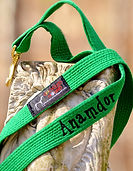COLLARS, LEASHES & FOOD








Collars
Regarding collars, while the puppies are growing we recommend just a regular nylon snap or buckle collar. For adults, I like leather, but there's no need to buy a nice leather collar until your puppy is full grown. A word of warning: if you allow free play with another dog, please make sure they are in a secure environment and remove the collars from both dogs. I myself have had a near miss with my own dogs getting their jaws stuck in each others' collars, and I can tell you firsthand how terrifying it is for both people and dogs. Denise has had friends who were not so lucky and lost a dog this way. So, please, either remove the collars or use a break-away collar during any play sessions (the brand shown is called a "keepsafe" collar.)
Leashes
We may be a little biased but the best leash available on the market today is the UpCycled Hound Karate Belt Leash. They are strong but very soft on your hands or on your dog's skin. They come in a wide range of colors with either a single handle or the double handle which has a 2nd handle near
the snap to allow you to grab your dog up close if necessary.
UpCycled Hound leashes can all be embroidered. These leashes
are available through Denise or on the website UpCycled Hound.
Crates
We always recommend crate training your puppy. The crate should never be used as punishment- rather, it should be a safe haven for your puppy. There are so many benefits to crate training- it helps with housebreaking, it's a safe place to put your puppy when they can't be supervised or if you just need a little break yourself. For those of you with show puppies, crate training is imperative to their success at dog shows! Please see this page for some wonderful tips on crate training. Crate Training - Association of Professional Dog Trainers
Crate sizing (wire kennels): most average-sized ridgeback females will fit comfortably in a 36" (length) crate. Most males, even very large ones, will fit comfortably in a 42" crate. Some of the longer/larger females may do better in a 42".
Keep in mind that you may need a divider for potty training your young puppy to keep him from soiling
one end of the crate and sleeping in the other.
Plastic airline style kennels (vari-kennels): We recommend
the "400" or Large size for females and the "500" or XL size for males.
Food
We wean our puppies to Fromm Large Breed Puppy food. This food is appropriate to continue for the first several months after they go home, but by the age of 9-12 months, they need to be switched to an adult food. The reason we do this is that ridgebacks are very fast-growing puppies, and it's imperative for healthy bone growth that we maintain the correct ratios of calcium and phosphorus. Adult foods tend to have a better ratio for large breeds, therefore, we switch them over early. We also do not want to feed anything too high in protein, so many of the grain-free, raw, and/or red meat diets are not recommended. Those foods are appropriate for them once the majority of long bone growth is done, at 16-18 months of age. We also feel that grain-free food should not be used right off the bat if the dog is not having problems; we would like to reserve these types of foods in case any sort of allergy or food intolerance develops in the future.
Special note about raw feeding: We are supportive of this method of feeding only if carefully researched and sourced prior to implementation. The raw diet is not one to take on without careful study and forethought. Although it is not "difficult" per se, it does require more effort and time than feeding a commercial diet, and a basic knowledge of the dietary needs of dogs and nutrition content of various types of raw food is necessary before you begin. This is particularly true with puppies, as their growth can be irreversibly impacted by an improperly balanced diet. Our best advice if you are interested in this type of feeding is to find a raw feeding mentor, join some of the facebook and/or email groups, read a few books, and then take the plunge. Our personal preference is for you to wait until the majority of growth is finished before switching to raw, just because we have seen first-hand the ramifications of unbalanced (both raw and commercial) diets.

